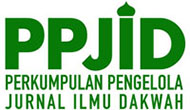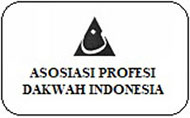Gender Construction in Feminist Da'wah by Women Preachers on Youtube
Abstract
Keywords
Full Text:
PDFReferences
Ahmad, A. (2014). Dinamika Komunikasi Islami di Media Online. Jurnal Ilmu Komunikasi, 11(April).
Anggoro, T. (2019). Konsep Kesetaraan Gender Dalam Islam. Afkaruna, 15(1). https://doi.org/10.18196/aiijis.2019.0098.129-134
Anggreani, L. (2020). Konstruksi Sosial Terhadap Perempuan Dalam Hukum Keluarga Islam (Analisis Gender). At-Turost : Journal of Islamic Studies, 6(2). https://doi.org/10.52491/at.v6i2.47
Berger, P., & Luckmann, T. (2016). The social construction of reality. In Social Theory Re-Wired: New Connections to Classical and Contemporary Perspectives: Second Edition. https://doi.org/10.4324/9781315775357
Daulay, M. R. (2020). Pandangan Islam Tentang Gender. Jurnal Kajian Gender Dan Anak, 2(1). https://doi.org/10.24952/gender.v2i1.2168
Eagly, A., & Wood, W. (2017). Gender identity: Nature and nurture working together. Evolutionary Studies in Imaginative Culture, Vol. 1. https://doi.org/10.26613/esic.1.1.10
Exford, A. (2016). The History of Youtube. Engadget.
Fatimah, D. (2015). Gender Dalam Teritori. Waca Cipta Ruang, 1(1). https://doi.org/10.34010/wcr.v1i1.1661
Hasanah, U. (2019). Gender Ddalam Dakwah Untuk Pembangunan (Potret Keterlibatan Perempuan dalam Politik). Jurnal Ilmu Dakwah, 38(2). https://doi.org/10.21580/jid.v38.2.3887
Marhumah. (2012). Konstruksi Gender, Hegemoni Kekuasaan, Dan Lembaga Pendidikan. Karsa, 19(2).
Nurhikmah, Nurhidayat, Halik, T. (2021). Adaptasi Dakwah Dalam Tradisi Tolak Bala Masyarakat Kota Parepare. Risalah: Jurnal Dakwah, 31(1).
Ritzer, G. (2012). Teori Sosiologi: Dari sosiologi klasik sampai perkembangan terakhir postmodern. Yogyakarta: Pustaka Pelajar.
Rohmatul Izzad. (2018). Konsep Kesetaraan Gender Dalam Islam. AL ITQAN: Jurnal Studi Al-Qur’an, 4(1). https://doi.org/10.47454/itqan.v4i1.678
Sa’dan, M. (2016). Rekonstruksi Materi Dakwah untuk Pemberdayaan Perempuan: Perspektif Teologi Feminisme. Jurnal Harkat : Media Komunikasi Gender, 12(1).
https://doi.org/10.15408/harkat.v12i1.7578
Said, N. M. (2014). Dakwah dan Berbagai Aspeknya (1st ed.). Makassar: Alauddin Press.
Setyani, N. I., Sri Hastjarjo, & Nora Nailul Amal. (2013). Penggunaan Media Sosial Sebagai Sarana Komunikasi bagi Komunitas. Komunikasi.
Suhada, D. N. (2021). Feminisme dalam Dinamika Perjuangan Gender di Indonesia. Indonesian Journal of Sociology, Education, and Development, 3(1), 15–27. https://doi.org/10.52483/ijsed.v3i1.42
Syam, T., Tajibu, K., Jasad, U., & Said, N. M. (2019). Bentuk Dakwah di Twitter Menjelang PILKADA DKI Jakarta Tahun 2017. Jurnal Diskursus Islam, 7(1), 149–186.
Tissier-Desbordes, E., & Visconti, L. M. (2019). Gender after gender: fragmentation, intersectionality, and stereotyping. Consumption Markets and Culture, Vol. 22. https://doi.org/10.1080/10253866.2018.1512238
Ahmad, A. (2014). Dinamika Komunikasi Islami di Media Online. Jurnal Ilmu Komunikasi, 11(April).
Anggoro, T. (2019). Konsep Kesetaraan Gender Dalam Islam. Afkaruna, 15(1). https://doi.org/10.18196/aiijis.2019.0098.129-134
Anggreani, L. (2020). Konstruksi Sosial Terhadap Perempuan dalam Hukum Keluarga Islam (Analisis Gender). At-Turost : Journal of Islamic Studies, 6(2). https://doi.org/10.52491/at.v6i2.47
Berger, P., & Luckmann, T. (2016). The social construction of reality. In Social Theory Re-Wired: New Connections to Classical and Contemporary Perspectives: Second Edition. https://doi.org/10.4324/9781315775357
Daulay, M. R. (2020). Pandangan Islam Tentang Gender. Jurnal Kajian Gender Dan Anak, 2(1). https://doi.org/10.24952/gender.v2i1.2168
Eagly, A., & Wood, W. (2017). Gender identity: Nature and nurture working together. Evolutionary Studies in Imaginative Culture, Vol. 1. https://doi.org/10.26613/esic.1.1.10
Exford, A. (2016). The History of Youtube. Engadget.
Fatimah, D. (2015). Gender Dalam Teritori. Waca Cipta Ruang, 1(1). https://doi.org/10.34010/wcr.v1i1.1661
Hasanah, U. (2019). Gender Dalam Dakwah untuk Pembangunan (Potret Keterlibatan Perempuan dalam Politik). Jurnal Ilmu Dakwah, 38(2). https://doi.org/10.21580/jid.v38.2.3887
Marhumah. (2012). Konstruksi Gender, Hegemoni Kekuasaan, Dan Lembaga Pendidikan. Karsa, 19(2).
Nurhikmah, Nurhidayat, Halik, T. (2021). Adaptasi Dakwah Dalam Tradisi Tolak Bala Masyarakat Kota Parepare. Risalah: Jurnal Dakwah, 31(1).
Ritzer, G. (2012). Teori Sosiologi: Dari sosiologi klasik sampai perkembangan terakhir postmodern. Yogyakarta: Pustaka Pelajar.
Rohmatul Izzad. (2018). Konsep Kesetaraan Gender dalam Islam. AL ITQAN: Jurnal Studi Al-Qur’an, 4(1). https://doi.org/10.47454/itqan.v4i1.678
Sa’dan, M. (2016). Rekonstruksi Materi Dakwah untuk Pemberdayaan Perempuan: Perspektif Teologi Feminisme. Jurnal Harkat : Media Komunikasi Gender, 12(1). https://doi.org/10.15408/harkat.v12i1.7578
Said, N. M. (2014). Dakwah dan Berbagai Aspeknya (1st ed.). Makassar: Alauddin Press.
Setyani, N. I., Sri Hastjarjo, & Nora Nailul Amal. (2013). Penggunaan Media Sosial Sebagai Sarana Komunikasi bagi Komunitas. Komunikasi.
Suhada, D. N. (2021). Feminisme dalam Dinamika Perjuangan Gender di Indonesia. Indonesian Journal of Sociology, Education, and Development, 3(1), 15–27. https://doi.org/10.52483/ijsed.v3i1.42
Syam, T., Tajibu, K., Jasad, U., & Said, N. M. (2019). Bentuk Dakwah di Twitter Menjelang PILKADA DKI Jakarta Tahun 2017. Jurnal Diskursus Islam, 7(1), 149–186.
Tissier-Desbordes, E., & Visconti, L. M. (2019). Gender after gender: fragmentation, intersectionality, and stereotyping. Consumption Markets and Culture, Vol. 22. https://doi.org/10.1080/10253866.2018.1512238
Video of dr. Ferihana. Banyak Suami Jahat, Tapi Kenapa Lebih Banyak Wanita di Neraka. 2020. Available in https://www.youtube.com/watch?v=h2QsV8jpe6M&t.
Video of dr. Ferihana. Kedudukan Istri Dalam Islam Sebuah Nasehat Yang Sangat Menampar Bagi Wanita. 2019. Available in https://www.youtube.com/watch?v=7HnMN-80qnc&t
Video of Lulung Mumtazah. Bagaimana Seorang Istri Seharusnya Bersikap dan Menasehati Suami. 2020. Available in https://www.youtube.com/watch?v=uadYQNle4x8
Video of Mama Dedeh. Ciri-Ciri Istri Durhaka Kepada Suami dan Ini Hukumannya. 2021. Available in https://www.youtube.com/watch?v=yZ5MtrMp7ow
Video of Mama Dedeh. Hukum Seorang Istri Mencari Nafkah Untuk Keluarga. 2020. Available in https://www.youtube.com/watch?v=tMWy1n2byVo&t.
Video of Oki Setiana Dewi. Ciri-ciri wanita Sholehah menurut Al-Quran. 2020. Available in https://www.youtube.com/watch?v=dcbCtvuc9Wo
Video of Oki Setiana Dewi. Keutamaan Wanita Yang Bekerja. 2021. Available in https://www.youtube.com/watch?v=BmoVr2V8Doo&t
Video of Oki Setiana Dewi. Menjadi Wanita Yang Dirindu Syurga. 2018. Available in https://www.youtube.com/watch?v=fqGGfA6RhSw&t
Watson, J., & Hill, A. (2015). Dictionary of Media and Communication Studies. In Dictionary of Media and Communication Studies. https://doi.org/10.5040/9781501304712
Wibawa, A. T. (2019). Fenomena Dakwah Di Media Sosial Youtube. Jurnal Rasi, 1(1).
Yamlean, P. V. Y., World Health Organization, Tondok, A. R., Kallo, R.,
Halifah, J., Supraptini, … Ardial. (2014). Paradigma dan Model Penelitian Komunikasi. Jurnal Kesehatan Masyarakat, 2(1).
Yuliatin, Y. (2019). Relasi Laki-Laki dan Perempuan di Ruang Domestik dan Publik Menurut Pemahaman Elit Pesantren Salafiyyah di Jambi. Musãwa Jurnal Studi Gender Dan Islam, 18(2). https://doi.org/10.14421/musawa.2019.182.161-171
DOI: http://dx.doi.org/10.24014/jdr.v32i2.15322
Refbacks
- There are currently no refbacks.

This work is licensed under a Creative Commons Attribution-ShareAlike 4.0 International License.
Editorial Office:
2nd Floor, Building of Faculty of Da'wah and Communication, Universitas Islam Negeri Sultan Syarif Kasim Riau. Jl. HR Soebrantas Km 15, Simpangbaru, Tampan, Pekanbaru
Email : jurnalrisalah@uin-suska.ac.id

This work is licensed under a Creative Commons Attribution-ShareAlike 4.0 International License.














